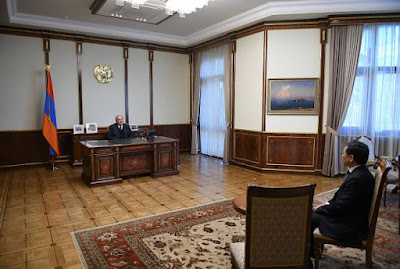Social Distancing in Diplomacy: A challenge to the historic norm
On
Monday (23/03/2020), President Armen Sarkissian of Armenia hosted the Chinese
Ambassador to Armenia Tian Erlong. Not long after, this image of the meeting
circulated on Twitter.
Due
to COVID-19 related social distancing, Sarkissian and Erlong sat incredibly far
away from one another. This is strikingly different to normal diplomatic meetings.
As I discussed in my first ever blog post, these usually involve two men
sitting very close to one another, often with a flag trying to get involved.
Sitting
near each other is not a new diplomatic practice. Perhaps the most famous
example of this occurred in 1945, at the Yalta Conference. Winston Churchill,
Joseph Stalin and Franklin Delano Roosevelt met there to discuss post-World War
Two Europe. During the Conference, a picture was taken of the trio sat together.
In
truth, this isn’t even a modern behaviour. Coins from the eighth century have
been discovered depicting two rulers sat next to one another, minted by both King Alfred of Wessex (871-99), and his contemporary King
Ceolwulf of Mercia (-c.879). We can infer that the coin is supposed to depict
the two Early English kings sat together.
There
is also an example of this in my own research on Anglo-Scottish and Anglo-Welsh
diplomacy between the years 927 and 1154. The twelfth-century chronicler John
of Hexham records the King of Scots’ son, Henry, visiting King Stephen of
England’s court in 1136. According to
John, ‘At the feast of Easter, King Stephen, in proof of the regard which he
felt for the same Henry, made him sit at his right hand.’
Leaders
and diplomats sit close together to indicate peace and good relations. As John states,
Stephen invited Henry to sit with him to demonstrate the respect and affection he
felt for the Scottish prince. Other evidence illustrates additional ways that
sitting together shows a positive relationship. In the Old English poem Beowulf,
the titular character sits with Hrethric and Hrothmund, the sons of King
Hrothgar and Queen Wealhtheow. Wealhtheow then gave a speech directed at
Beowulf, saying ‘be kindly disposed towards these boys in giving them good
counsels.’ The reference to ‘good counsels’ shows that Beowulf was expected to
talk to the boys, something that was made much easier by their close proximity.
Thus, two people sitting together was a metaphor for not just a positive
relationship, but one based on good communication. Finally, in his book Family,
Friends and Followers; Political and Social Bonds in Early Medieval Europe,
Gerd Althoff points out that the people in these situations are actually pretty
vulnerable. They are unarmed and unsuspecting, whilst surrounded by members of
a foreign, and potentially hostile, group. Sitting with a foreign diplomat or
leader visually shows people how good your relationship with them is, since you
trust that nothing bad will happen to you whilst you’re in this vulnerable position.
The context of these episodes
further proves the relationship between sitting near someone and having a good
relationship with them. Henry’s visit to Stephen’s court came in the aftermath
of an Anglo-Scottish conflict. In early 1136, King David of Scots invaded
northern England, capturing Newcastle and Carlisle. Peace was negotiated at
Durham, after which Henry of Scots travelled south for his visit to King
Stephen. The pair sitting together was a way to confirm to the English court
that the war was over and that peace had been re-established.
Similarly, Alfred and Ceolwulf’s
coin was issued during a period of frequent Viking invasions. The image likely
illustrated an alliance between the two English rulers versus the Scandinavian
attackers, though the contemporary written sources do not provide any evidence
for this. The sources were produced by supporters of Alfred though, so likely sought
to play down any help he received from other kings. Likewise, the Yalta picture
was taken in the context of the USA-UK-USSR alliance against Germany.
What does this tell us about
diplomacy during the COVID-19 pandemic, and the meeting between the Armenian
President and the Chinese Ambassador? Well there is a negative and a positive interpretation.
On one hand, sitting so far apart, in clear defiance of diplomatic norms, could
demonstrate how much COVID-19 is separating everyone and challenging traditional
beliefs. However, I prefer a more positive view. During this global pandemic,
these men, and the states they represent, are facing a common enemy. That they
still held a face to face meeting symbolises not just good relations, but also
their alliance against COVID-19. A telephone call would have been much easier,
but the image of the two men in the same room is a far more powerful act of public
diplomacy.
Bibliography
Althoff,
Gerd, Family, Friends and Followers:
Political and Social Bonds in Early Medieval Europe, trans. by Christopher
Carroll (Cambridge: Cambridge University Press, 2004).
Armen
Press: https://armenpress.am/eng/news/1009686.html
Ashmolean
Museum: https://www.ashmolean.org/watlington-hoard
Beowulf,
in Beowulf and Other Old English Poems,
ed. and trans. by Craig Williamson, for. by Tom Shippey (Philadelphia:
Pennsylvania Press, 2011), pp. 443-44.
Henry,
Archdeacon of Huntingdon, Historian
Anglorum, ed. and trans. by Diana Greenaway (Oxford: Clarendon Press, 1996),
pp. 707.
Igor
Denisov on Twitter: https://twitter.com/Igor_Denisov/status/1242156392124989441
John
the Prior, The History of the Church of Hexham, The Church historians of England, ed. and trans. by Joseph
Stevenson, 5 vols. (London: Seeleys 1853-58), 4, p. 6.
Yalta
Conference on Wikipedia: https://en.wikipedia.org/wiki/Yalta_Conference







Comments
Post a Comment